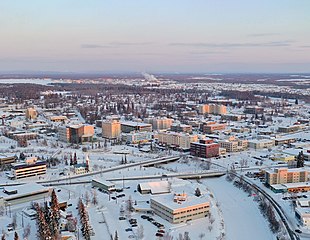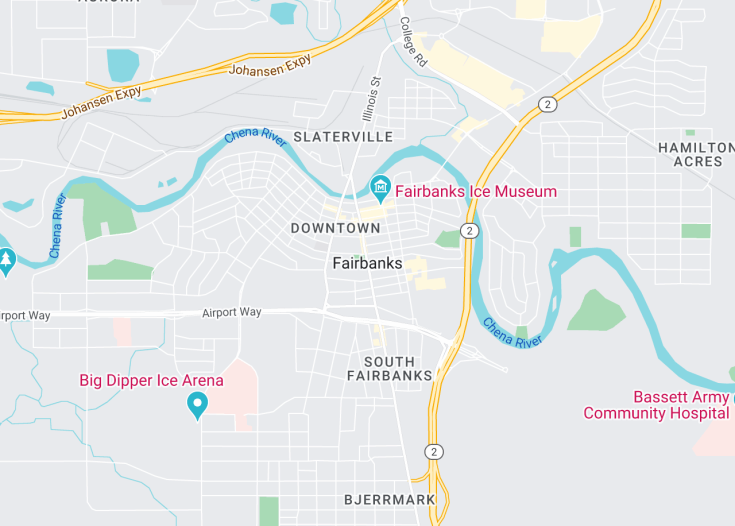Nestled in the heart of interior Alaska, Fairbanks stands as a stunning gateway to the Arctic, offering a unique blend of natural beauty and cultural heritage. Known as the Golden Heart City, Fairbanks enchants visitors with its vibrant display of the northern lights, rich gold rush history, and access to pristine wilderness areas. It provides an ideal backdrop for a range of activities, including dog sledding, ice fishing, and cross-country skiing, making it a quintessential destination for adventurers and nature lovers alike.
When visiting Fairbanks, ensure to plan your trip between September and April for the best northern lights viewing experience.
Consider a guided tour to truly embrace the natural and cultural riches of Fairbanks, which includes visits to local museums and nearby natural parks.
Top things to do & see in Fairbanks
Select the following sights and activities to discover best tickets and tours available in Fairbanks.
Fairbanks: The Golden Heart of Alaska
| Country | Alaska (USA) |
| Time in Fairbanks | GMT-8:00 |
| Language spoken | English |
| Population | 31,000 (source: latest census) |
| Currency | United States Dollar (USD $) |
| Airports |
|
Fairbanks, the second-largest city in Alaska, is steeped in history and rich culture. Known as the ‘The Golden Heart of Alaska,’ it serves as the regional hub for the Interior region of Alaska and is renowned for its unique geographical location under the aurora oval—making it one of the best spots in the world to witness the spectacular Northern Lights. The city was founded in the early 1900s during the Gold Rush era and has since evolved into a central point for commerce and transportation within Alaska. Fairbanks experiences extreme temperature variations, where summer can bring 24 hours of sunlight, known as the midnight sun, and winter may immerse the city into complete darkness during the polar nights. This unique aspect defines the lifestyle and culture of Fairbanks, where residents enjoy outdoor activities such as dog sledding, ice carving during the renowned World Ice Art Championships, and soaking in the area’s rich natural hot springs.
Culturally, Fairbanks is very vibrant, hosting several annual festivals and events that celebrate the history and traditions of Alaska’s indigenous peoples, as well as modern Alaskan life. The University of Alaska Fairbanks adds a youthful energy to the city with academic pursuits and research contributions, particularly in fields related to northern climate and energy.
The city’s economy pivots largely on tourism, military, local and federal government services, and the University. Despite its remote location, Fairbanks is relatively connected to other parts of Alaska and the lower 48 states through a network of highways and a well-established rail link.
Where is Fairbanks?
Fairbanks is located in the heart of Alaska’s interior, surrounded by wilderness and striking mountain ranges.
Distances:
| Route | Distance by car | Time by car |
|---|---|---|
| Anchorage to Fairbanks | 360 miles | 6 hours |
| Juneau to Fairbanks | 677 miles (includes ferry) | 14 hours |
What is Fairbanks famous for?
Fairbanks is famous for its spectacular view of the Northern Lights, visible over 200 days a year, and its rich gold mining history, which visibly influences the culture and heritage of the city.
History
Pre-1900: Indigenous Beginnings to Frontier Outpost
Before its establishment as a city, the land surrounding Fairbanks was predominantly inhabited by nomadic Athabascan Native Americans, including the Koyukon. The area’s vast wilderness provided ample hunting and fishing, which sustained local tribes for generations. It wasn’t until the late 19th century that traders and miners began exploring the interior of Alaska, attracted by the promise of wealth and new opportunities.
1901-1959: Gold Rush Boom to Strategic Military Centres
The modern era of Fairbanks began with the founding by Captain E.T. Barnette in 1901. Shortly thereafter, gold was discovered, triggering a massive influx of miners during the Alaska Gold Rush. The city quickly developed, building infrastructure including railroads and roads largely driven by the mining economy. During World War II and the Cold War, Fairbanks’s geographical significance was recognized by the U.S. military, which established bases in the area, further boosting the local economy and population growth.
1960-Present: Economic Diversification and Tourism Development
Post-1960s, Fairbanks adapted to the decline of gold mining by diversifying its economy, focusing more on oil and natural gas, education, and tourism. Today, it serves not only as an economic hub of the Interior region but also as a gateway for arctic research, with institutions like the University of Alaska Fairbanks contributing significantly. Tourism has become a vital part of the economy, driven by the region’s stunning natural beauty and unique opportunities to witness phenomena like the aurora borealis.
Visit Fairbanks
What to see and do in Fairbanks, Alaska (USA)
Visitors to Fairbanks, Alaska, can experience a rich mixture of cultural history, natural beauty, and unique arctic phenomena. Notable attractions include:
- The University of Alaska Museum of the North, offering insights into Alaskan natural history and indigenous cultures.
- Chena Hot Springs Resort, known for its relaxing thermal waters and ice museum.
- The Northern Lights, visible during the winter months, providing a breathtaking spectacle.
- Running Reindeer Ranch for a close-up encounter with Alaskan reindeer.
- Historic sites like Fairbanks Gold Rush Town, which transports visitors back to the Gold Rush era.
Exploring the vast wilderness areas through activities like dog sledding, hiking, and ice fishing also makes for an unforgettable visit.
Annual Events in Fairbanks
Fairbanks is home to a variety of events that reflect its unique culture and environment. Key events include:
- The World Ice Art Championships in March, where spectacular ice sculptures draw international artists and spectators.
- The Midnight Sun Festival in June, celebrating the summer solstice with 24 hours of daylight.
- The Yukon Quest Dog Sled Race in February, which is one of the toughest sled dog races in the world.
These events provide visitors with a deep dive into local traditions and the vibrant community spirit of Fairbanks.
Best time to visit Fairbanks
The best time to visit Fairbanks depends largely on what experiences you seek. For those wishing to see the Northern Lights, the best months are from September to March when the nights are long and dark. Conversely, the summer months, particularly from June to August, offer nearly 24 hours of daylight and are ideal for hiking, wildlife viewing, and participating in the Midnight Sun Festival.
Is Fairbanks worth visiting?
Fairbanks is indeed worth visiting. It provides a unique blend of cultural heritage, incredible natural scenery, and one-of-a-kind experiences like viewing the aurora borealis or exploring the Arctic Circle. Whether you are a history enthusiast, nature lover, or adventure seeker, Fairbanks offers something compelling for every visitor, making it a resilient and enriching travel destination.











